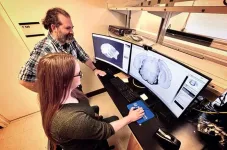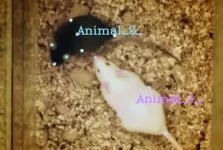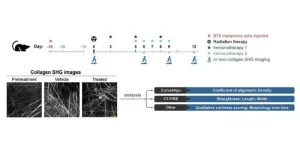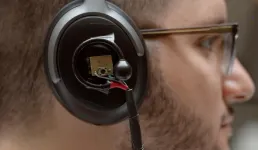(Press-News.org) Artificial intelligence software has been developed to rapidly analyze animal behavior so that behaviors can be more precisely linked to the activity of individual brain circuits and neurons, researchers in Seattle report.
The program promises not only to speed research into the neurobiology of behavior, but also to enable comparison and reconcile results that disagree due to differences in how individual laboratories observe, analyze and classify behaviors, said Sam Golden, assistant professor of biological structure at the University of Washington School of Medicine.
“The approach allows labs to develop behavioral procedures however they want and makes it possible to draw general comparisons between the results of studies that use different behavioral approaches,” he said.
A paper describing the program appears in the journal Nature Neuroscience. Golden and Simon Nilsson, a postdoctoral fellow in the Golden lab, are the paper’s senior authors. The first author is Nastacia Goodwin, a graduate student in the lab.
The study of the neural activity behind animal behavior has led to major advances in the understanding and treatment of such human disorders as addiction, anxiety and depression.
Much of this work is based on observations painstakingly recorded by individual researchers who watch animals in the lab and note their physical responses to different situations, then correlate that behavior with changes in brain activity.
For example, to study the neurobiology of aggression, researchers might place two mice in an enclosed space and record signs of aggression. These would typically include observations of the animals’ physical proximity to one another, their posture, and physical displays such as rapid twitching, or rattling, of the tail.
Annotating and classifying such behaviors is an exacting, protracted task. It can be difficult to accurately recognize and chronicle important details, Golden said. “Social behavior is very complicated, happens very fast and often is nuanced, so a lot of its components can be lost when an individual is observing it.”
To automate this process, researchers have developed AI-based systems to track components of an animal’s behavior and automatically classify the behavior, for example, as aggressive or submissive.
Because these programs can also record details more rapidly than a human, it is much more likely that an action can be closely correlated with neural activity, which typically occurs in milliseconds.
One such program, developed by Nilsson and Goodwin, is called SimBA, for Simple Behavioral Analysis. The open-source program features an easy-to-use graphical interface and requires no special computer skills to use. It has been widely adopted by behavioral scientists.
“Although we built SimBA for a rodent lab, we immediately started getting emails from all kinds of labs: wasp labs, moth labs, zebrafish labs,” Goodwin said.
But as more labs used these programs, the researchers found that similar experiments were yielding vastly different results.
“It became apparent that how any one lab or any one person defines behavior is pretty subjective, even when attempting to replicate well-known procedures,” Golden said.
Moreover, accounting for these differences was difficult because it is often unclear how AI systems arrive at their results, their calculations occurring in what is often characterized as “a black box.”
Hoping to explain these differences, Goodwin and Nilsson incorporated into SimBA a machine-learning explainability approach that produces what is called the Shapely Additive exPlanations (SHAP) score.
Essentially what this explainability approach does is determine how removing one feature used to classify a behavior, say tail rattling, changes the probability of an accurate prediction by the computer.
By removing different features from thousands of different combinations, SHAP can determine how much predictive strength is provided by any individual feature used in the algorithm that is classifying the behavior. The combination of these SHAP values then quantitatively defines the behavior, removing the subjectivity in behavioral descriptions.
“Now we can compare (different labs’) respective behavioral protocols using SimBA and see whether we’re looking, objectively, at the same or different behavior,” Golden said.
“This approach allows labs to design experiments however they like, but because you can now directly compare behavioral results from labs that are using different behavioral definitions, you can draw clearer conclusions between their results. Previously, inconsistent neural data could have been attributed to many confounds, and now we can cleanly rule out behavioral differences as we strive for cross-lab reproducibility and interpretability” Golden said.
This research was supported by grants from the National Institutes of Health (K08MH123791), the National Institute on Drug Abuse (R00DA045662, R01DA059374, P30DA048736), National Institute of Mental Health (1F31MH125587, F31AA025827, F32MH125634), National Institute of General Medicine Sciences (R35GM146751), Brain & Behavior Research Foundation, Burroughs Wellcome Fund, Simons Foundation, and Washington Research Foundation.
END
Artificial intelligence resolves conflicts impeding animal behavior research
Algorithm automates research and reconciles differing results that often arise between various studies.
2024-05-24
ELSE PRESS RELEASES FROM THIS DATE:
Barrow Neurological Institute expands Phoenix research footprint with the opening of new neuro analytics center
2024-05-24
Barrow Neurological Institute has opened a new cutting-edge research center that is expected to revolutionize neurological research and expand Phoenix’s research footprint into the areas of environmental neurology and health equity.
The Barrow Neuro Analytics Center, located at the Park Central property in the Phoenix Medical Quarter, comprises a 10,099 square-foot dry laboratory housing 10 principal research investigators and their dedicated teams. These experts delve into critical areas such as environmental epidemiology, advanced neuroimaging, global health, neurological drug development, health ...
Study: Integration of pharmacies with physician practices has little impact on cancer drug expenditures
2024-05-24
Integration of pharmacies with physician practices, where on-site pharmacies open at physician practice locations, is a growing trend in cancer treatment. However, little is known about how this integration affects drug utilization or expenditures, along with other aspects of the patient experience.
A study published today in JAMA Network Open compared the outcomes of patients treated by oncologists whose practices integrated with pharmacies, to those of oncologists that did not integrate. Researchers found a slight increase in utilization of oral oncology drugs, but no significant change in expenditures on the drugs.
In addition, there were no discernible ...
Penn Medicine at the 2024 ASCO Annual Meeting
2024-05-24
CHICAGO – Researchers from Penn Medicine’s Abramson Cancer Center (ACC) and the Perelman School of Medicine at the University of Pennsylvania will present data on the latest advances in cancer research at the 2024 American Society of Clinical Oncology (ASCO) Annual Meeting, happening May 31—June 4, 2024 in Chicago and online. Follow @PennMedicine and @PennMDForum for updates.
Expert interviews
Experts from Penn Medicine are available to comment on a wide range of cancer research and care topics before, during, and after the meeting by video call, phone, or email. To arrange interviews, ...
Groundbreaking study connects genetic risk for autism to changes observed in the brain
2024-05-24
A groundbreaking study led by UCLA Health has unveiled the most detailed view of the complex biological mechanisms underlying autism, showing the first link between genetic risk of the disorder to observed cellular and genetic activity across different layers of the brain.
The study is part of the second package of studies from the National Institutes of Health consortium, PsychENCODE. Launched in 2015, the initiative, chaired by UCLA neurogeneticist Dr. Daniel Geschwind, is working to create maps of gene regulation across different regions of the brain and different stages of brain development. The consortium aims to bridge the gap between studies ...
NFL’s Buffalo Bills continue CPR education kicking off year 2 of the HeartBEAT initiative
2024-05-23
DALLAS, May 23, 2024 —According to American Heart Association data, 9 out of every 10 people who experience cardiac arrest outside of a hospital die. This is in part because they do not receive immediate cardiopulmonary resuscitation (CPR) more than half of the time. CPR, especially if performed immediately, can double or triple a person’s chance of survival. The American Heart Association and the Buffalo Bills want more people to be confident and capable when faced with a cardiac emergency. Through the HeartBEAT ...
Renewable grid: Recovering electricity from heat storage hits 44% efficiency
2024-05-23
Images
Closing in on the theoretical maximum efficiency, devices for turning heat into electricity are edging closer to being practical for use on the grid, according to University of Michigan research.
Heat batteries could store intermittent renewable energy during peak production hours, relying on a thermal version of solar cells to convert it into electricity later.
"As we include higher fractions of renewables on the grid to reach decarbonization goals, we need lower costs and longer durations of ...
Galaxies actively forming in early universe caught feeding on cold gas
2024-05-23
Researchers analyzing data from NASA’s James Webb Space Telescope have pinpointed three galaxies that may be actively forming when the universe was only 400 to 600 million years old. Webb’s data shows these galaxies are surrounded by gas that the researchers suspect to be almost purely hydrogen and helium, the earliest elements to exist in the cosmos. Webb’s instruments are so sensitive that they were able to detect an unusual amount of dense gas surrounding these galaxies. This gas will likely end up fueling the formation of new stars in the galaxies.
“These ...
Developing novel methods to detect antibiotics in vegetables and earthworms
2024-05-23
“The massive use of antibiotics and antimicrobials in people and animals has led to these substances appearing in unexpected environmental samples,” said Irantzu Vergara, researcher in the UPV/EHU’s IBeA group. Drugs that do not end up fully metabolised in the body reach the environment through various routes (such as manure, sewage sludge used as fertilisers, etc.), are leached into the soil and may end up transferring to crops or earthworms, which are at the base of the food chain. “Although ...
New biomarkers of response in melanoma immunotherapy
2024-05-23
Collagen, a major component of the extracellular matrix, plays a crucial role in tumor development. During the development of tumors (“tumorigenesis”), collagen fibers become linearized and densely deposited, hindering immune cell infiltration and promoting tumor metastasis. However, quantifying these collagen changes during melanoma progression has been challenging.
In-vivo imaging of collagen
As reported in Biophotonics Discovery, researchers from the Morgridge Institute for Research and University of Wisconsin – Madison recently addressed this challenge by using quantitative imaging to visualize collagen ...
AI headphones let wearer listen to a single person in a crowd, by looking at them just once
2024-05-23
Noise-canceling headphones have gotten very good at creating an auditory blank slate. But allowing certain sounds from a wearer’s environment through the erasure still challenges researchers. The latest edition of Apple’s AirPods Pro, for instance, automatically adjusts sound levels for wearers — sensing when they’re in conversation, for instance — but the user has little control over whom to listen to or when this happens.
A University of Washington team has developed an artificial intelligence system that lets a ...
LAST 30 PRESS RELEASES:
Maternity baby deaths much higher in northern England than in the South
Mosquitoes’ thirst for human blood has increased as biodiversity loss worsens
The stop-smoking medication varenicline may also work for cannabis use disorder
Potential new treatment for sepsis
Study reveals how many hours of video games per week might be too many
Electrospinning for mimicking bioelectric microenvironment in tissue regeneration
Home fingertip oxygen monitors less accurate for people with darker skin tones
Six weeks in a cast no less effective than surgery for unstable ankle fractures
Precautionary approach to alcohol-free and low alcohol drinks needed to protect public health, say experts
Gas-atomized Ca–Mg alloy powders produce hydrogen simply by adding water — high-efficiency hydrogen generation at room temperature
British redcoat’s lost memoir reveals harsh realities of life as a disabled veteran
World-leading rare earth magnet recycling facility launches in UK
Corday Selden selected for the Oceanography Society Early Career Award
MIT chemists determine the structure of the fuzzy coat that surrounds Tau proteins
Same moves, different terrain: How bacteria navigate complex environments without changing their playbook
Severe weather is deadly for vulnerable older adults long after the storm ends, study finds
Expert panel highlights opportunities for improving cancer studies
Hearing aid prescriptions not associated with changes in memory and thinking
Seth Zippel selected for The Oceanography Society Early Career Award
Jeremy Horowitz selected for The Oceanography Society Early Career Award
Kennesaw State University’s Jerry Mack named Paul “Bear” Bryant Newcomer Coach of the Year
Ancient teeth are treasure troves of data on Iron Age lifestyles
Avocados may become easier to grow in India—but not if global emissions remain high
Pregnant women with IBD show heightened inflammation in vaginal mucosa
Underwater photos show seabirds, seals and fish interacting with a tidal turbine in Washington State
1 in 5 surveyed UK adults who have experienced the death of a pet report it as more distressing than experienced human deaths, with significant rates of prolonged grief disorder symptoms also being re
Polyester microfibers in soil negatively impact the development of cherry tomato plants in experiments, raising concerns over the potential effect of high levels of such contaminants
LGBTQ+ adults may be around twice as likely to be unemployed or to report workforce non-participation compared to heterosexual adults, per large representative Australian survey
Horses can smell fear: In experiments where horses smelled sweat from scared humans, they reacted to scary and sudden events with increased fear and reduced human interaction
New synaptic formation in adolescence challenges conventional views of brain development
[Press-News.org] Artificial intelligence resolves conflicts impeding animal behavior researchAlgorithm automates research and reconciles differing results that often arise between various studies.




